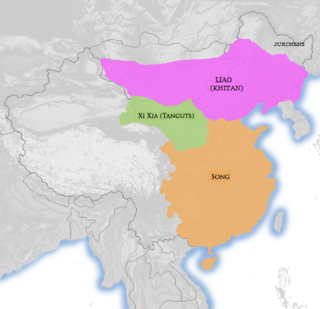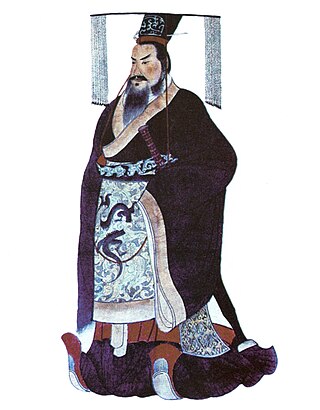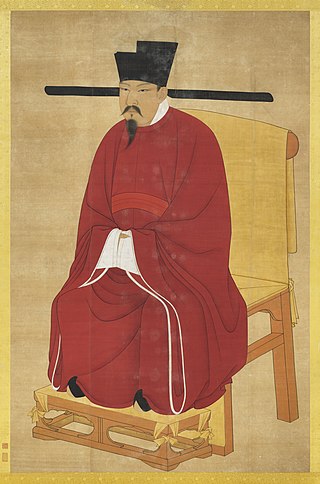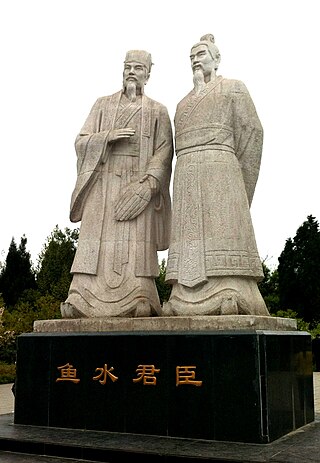
The Xia dynasty is the first dynasty in traditional Chinese historiography. According to tradition, it was established by the legendary figure Yu the Great, after Shun, the last of the Five Emperors, gave the throne to him. In traditional historiography, the Xia was succeeded by the Shang dynasty.
The Chinese sovereign was the ruler of a particular monarchical regime in the historical periods of ancient China and imperial China. Sovereigns ruling the same regime, and descended from the same paternal line, constituted a dynasty. Several titles and naming schemes have been used throughout Chinese history.

The Western Xia or the Xi Xia (Chinese: 西夏; pinyin: Xī Xià; Wade–Giles: Hsi1 Hsia4), officially the Great Xia (大夏; Dà Xià; Ta4 Hsia4), also known as the Tangut Empire, and known as Mi-nyak to the Tanguts and Tibetans, was a Tangut-led Buddhist imperial dynasty of China that existed from 1038 to 1227. At its peak, the dynasty ruled over modern-day northwestern China, including parts of Ningxia, Gansu, eastern Qinghai, northern Shaanxi, northeastern Xinjiang, and southwest Inner Mongolia, and southernmost Outer Mongolia, measuring about 800,000 square kilometres (310,000 square miles).

The nobility of China represented the upper strata of aristocracy in premodern China, acting as the ruling class until c. 1000 CE, and remaining a significant feature of the traditional social structure until the end of the imperial period.

King Wu of Zhou was the founder and first king of the Zhou dynasty. The chronology of his reign is disputed but is generally thought to have begun around 1046 BCE and ended with his death three years later.

Emperor Hui of Jin, personal name Sima Zhong (司馬衷), courtesy name Zhengdu (正度), was the second emperor of the Jin dynasty (266–420). Emperor Hui was a developmentally disabled ruler, and throughout his reign, there was constant internecine fighting between regents, imperial princes, and his wife Empress Jia Nanfeng for the right to control him, causing great suffering for the people and greatly undermining the stability of the Western Jin dynasty, eventually leading to rebellions of the Five Barbarians that led to Jin's loss of northern and central China and the establishment of the competing Sixteen Kingdoms. He was briefly deposed by his granduncle Sima Lun, who usurped the throne himself, in 301, but later that year was restored to the throne and continued to be the emperor until January 307, when he was poisoned, likely by the regent Sima Yue.

The Emperor Shenzong of Song, personal name Zhao Xu, was the sixth emperor of the Song dynasty of China. His original personal name was Zhao Zhongzhen but he changed it to "Zhao Xu" after he acceded to the throne. He reigned from 1067 until his death in 1085 and is best known for supporting Wang Anshi's New Policies. He was a particularly active monarch concerned with solving the fiscal, bureaucratic, and military problems of the Song dynasty, but his reign remains controversial.
King Zhuangxiang of Qin, personal names Yiren and Zichu, was the penultimate ruler of the Qin state during the third century BCE in the Warring States period of ancient China.
For most of its history, China was organized into various dynastic states under the rule of hereditary monarchs. Beginning with the establishment of dynastic rule by Yu the Great c. 2070 BC, and ending with the abdication of the Xuantong Emperor in AD 1912, Chinese historiography came to organize itself around the succession of monarchical dynasties. Besides those established by the dominant Han ethnic group or its spiritual Huaxia predecessors, dynasties throughout Chinese history were also founded by non-Han peoples.

Zheng was a vassal state in China during the Zhou Dynasty located in the centre of ancient China in modern-day Henan Province on the North China Plain about 75 miles (121 km) east of the royal capital at Luoyang. It was the most powerful of the vassal states at the beginning of the Eastern Zhou, and was the first state to clearly establish a code of law in its late period of 543 BCE. Its ruling house had the ancestral name Ji (姬), making them a branch of the Zhou royal house, who held the rank of Bo (伯), a kinship term meaning "elder".

Emperor Wen of Sui, personal name Yang Jian (楊堅), Xianbei name Puliuru Jian (普六茹堅), alias Narayana deriving from Buddhist terms, was the founding emperor of the Chinese Sui dynasty. As a Buddhist, he encouraged the spread of Buddhism through the state. He is regarded as one of the most important emperors in Chinese history, reunifying China proper in 589 after centuries of division since the independence of the Cheng-Han and Han-Zhao dynasties from the Western Jin dynasty in 304. During his reign, the construction of the Grand Canal began.

The Battle of Muye, Mu, or Muh took place in ancient China between the rebel Zhou state and the reigning Shang dynasty. The Zhou army, led by Wu of Zhou, defeated the defending army of king Di Xin of Shang at Muye and captured the Shang capital Yin, ending the Shang dynasty. The Zhou victory led to the establishment of the Zhou dynasty, and is used in Chinese historiography as a justified example of the doctrine of the Mandate of Heaven.

The grand chancellor, also translated as counselor-in-chief, chancellor, chief councillor, chief minister, imperial chancellor, lieutenant chancellor and prime minister, was the highest-ranking executive official in the imperial Chinese government. The term was known by many different names throughout Chinese history, and the exact extent of the powers associated with the position fluctuated greatly, even during a particular dynasty.
Máng was the ninth king of the semi-legendary Xia dynasty. He possibly ruled 18 years. He was also known as Huang (荒).
Xie was the tenth king of the semi-legendary Xia dynasty. The son of Mang, Xie ascended the throne in the "Xinwei" (辛未) year. He possibly ruled 25 years.
Jiong was the twelfth king of the semi-legendary Xia dynasty.
Kǒng Jiǎ (孔甲) was a king of ancient China, family name Sì (姒), the 14th ruler of the semi-legendary Xia dynasty. He possibly ruled for 31 years.

In Chinese history, a Taishang Huang or Taishang Huangdi is an honorific and institution of a retired emperor. The former emperor had, at least in name, abdicated in favor of someone else. Although no longer the reigning sovereign, there are instances where the retired emperor became a power behind the throne, often exerting more power than the reigning emperor.
The Great Flood of Gun-Yu, also known as the Gun-Yu myth, was a major flood in ancient China that allegedly continued for at least two generations, which resulted in great population displacements among other disasters, such as storms and famine. People left their homes to live on the high hills and mountains, or nest on the trees. According to mythological and historical sources, it is traditionally dated to the third millennium BCE, or about 2300-2200 BCE, during the reign of Emperor Yao.
The following outline is provided as an overview of and topical guide to ancient China:










